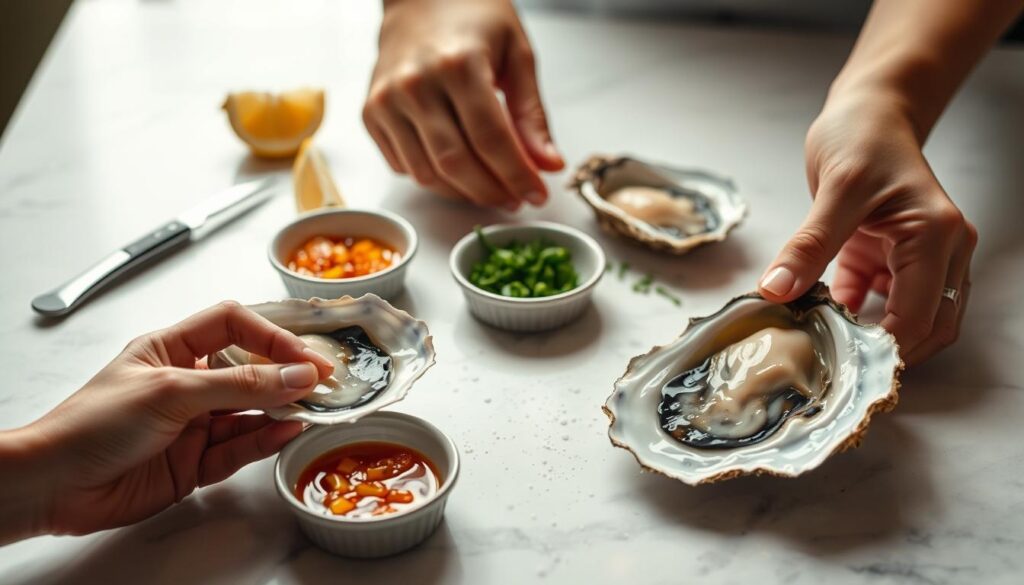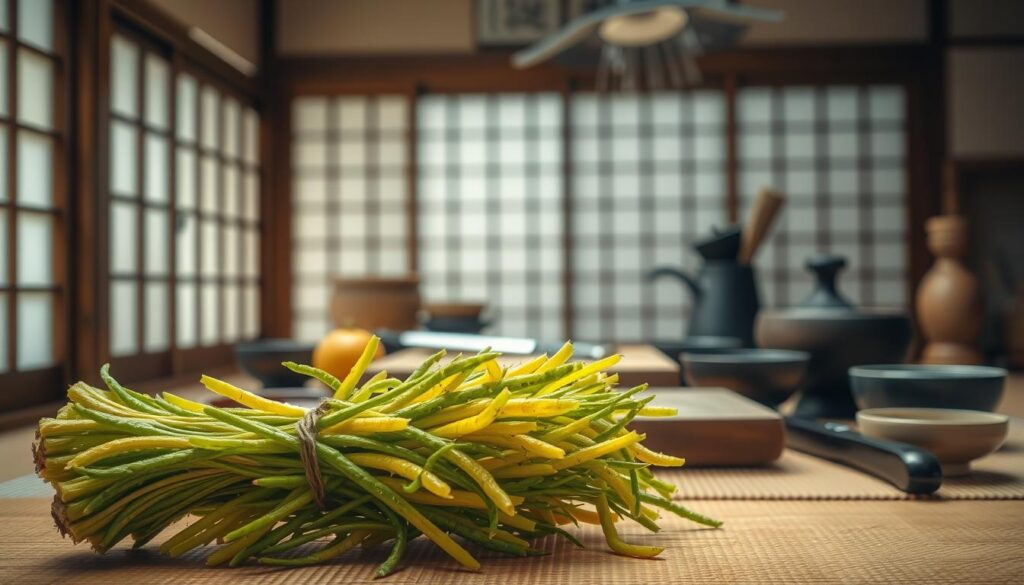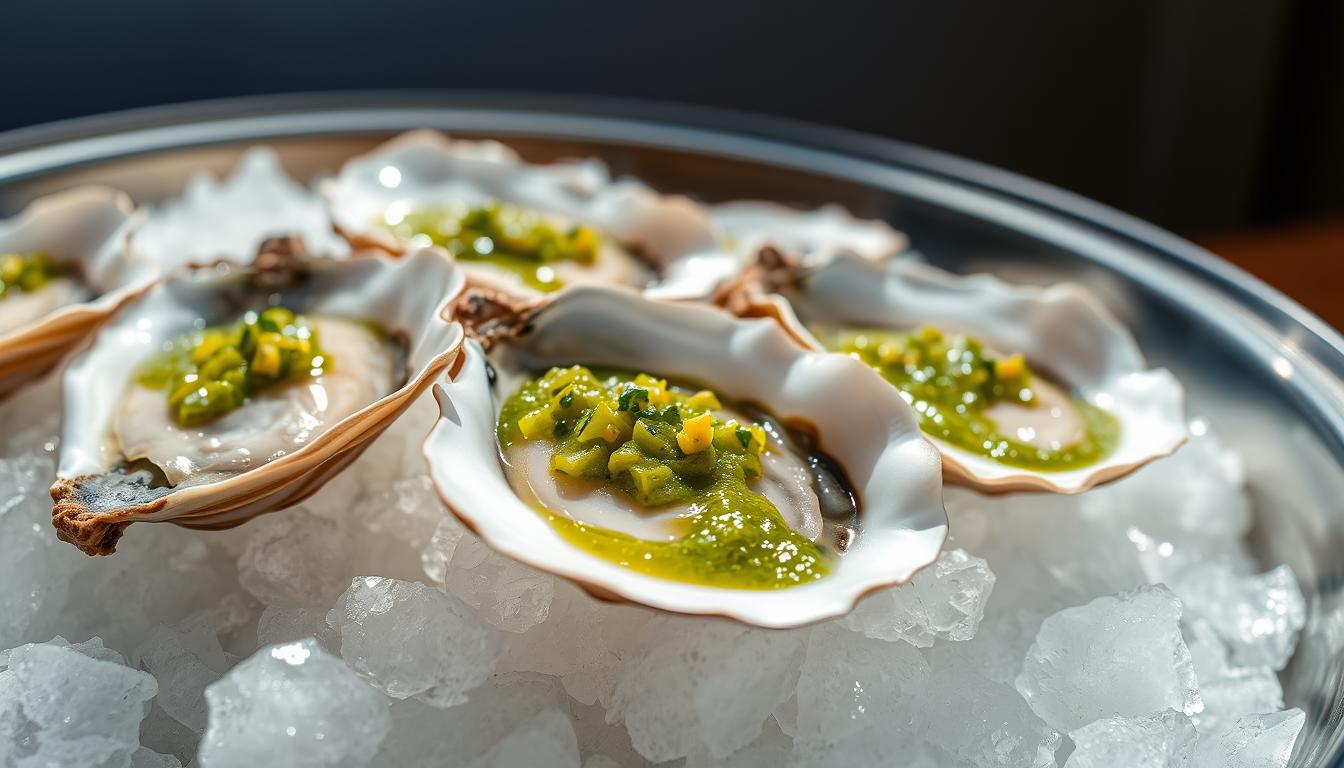Explore the world of Japanese cuisine with a seafood delicacy that will change your cooking game. Oysters with Yuzu Kosho Mignonette mix the freshness of the sea with a zesty kick. This combo makes every taste bud come alive.
Get ready for a thrilling taste adventure. Briny oysters meet the vibrant kick of yuzu kosho. This amazing mix takes the traditional raw bar to new heights. It combines the sweet taste of fresh oysters with the citrusy heat of Japanese spices.
Table of Contents
Understanding the Art of Oyster Preparation
Learning to prepare oysters is key in the raw bar world. It starts with knowing the detailed techniques that turn simple shellfish into a gourmet treat. Professional chefs say that being precise and respecting the ingredient are crucial for a great oyster dish.

Traditional Shucking Techniques
Shucking oysters needs skill and patience. Here are the main techniques to learn:
- Protect your hand with a thick towel or specialized glove
- Hold the oyster with the cupped side down
- Insert the oyster knife at the hinge point
- Twist gently to separate the shells
- Carefully detach the meat from the top shell
Essential Tools for Oyster Preparation
Your raw bar toolkit should have special equipment for perfect oyster prep:
- Oyster knife – made for its short, sturdy blade
- Cut-resistant gloves for hand protection
- Stable cutting board
- Clean kitchen towel
Safety Measures When Handling Raw Oysters
Food safety is crucial when working with raw seafood. Keep oysters chilled, clean your workspace well, and eat them fresh. Always buy from trusted suppliers to avoid risks with raw shellfish.
Pro tip: Fresh oysters should smell like the ocean – clean and briny, never fishy.
The Origins of Yuzu Kosho in Japanese Cuisine

Yuzu kosho is a key part of Japanese food, known for its deep umami flavors. It mixes the fresh taste of yuzu citrus with the spicy kick of chili peppers. This mix creates a flavor that chefs and food lovers around the world love.
The story of yuzu kosho starts in Japan’s southern areas, like Kyushu. There, people used to ferment ingredients to keep them fresh. They found that mixing yuzu peels, green chili peppers, and sea salt made a strong condiment. This condiment made dishes taste better.
- Traditional preparation involves hand-grinding ingredients
- Fermentation process develops intense umami flavors
- Used sparingly to add complex taste dimensions
In Japanese cooking, yuzu kosho has many uses. Chefs use it to make seafood dishes stand out, adding a zesty and spicy touch. It’s also loved by chefs who want to make old recipes new again.
Yuzu kosho represents the perfect balance of citrus, heat, and depth in Japanese cooking.
Yuzu kosho is used in many ways, like as a garnish or in sauces. It keeps food lovers interested with its deep history and amazing taste.
Oysters with Yuzu Kosho Mignonette: The Perfect Pairing
Discovering the art of Oysters with Yuzu Kosho Mignonette turns a simple seafood meal into a journey of flavors. This mix combines the salty taste of raw oysters with a zesty citrus vinaigrette. It wakes up your taste buds.
When making this dish, getting the flavors just right is key. The culinary precision needed makes every bite unforgettable.
Balancing Flavors and Textures
Your mignonette needs to blend perfectly:
- Bright citrus notes from yuzu juice
- Subtle heat of yuzu kosho
- Delicate shallot undertones
- Briny oyster essence
Proper Serving Temperature
Temperature is crucial for enjoying Oysters with Yuzu Kosho Mignonette. Serve oysters ice-cold, between 33-40°F. This keeps their texture delicate and enhances flavor.
Plating Presentation Tips
Enhance your presentation with these tips:
- Use a bed of crushed ice to keep oysters chilled
- Arrange oysters symmetrically on a large platter
- Drizzle citrus vinaigrette sparingly
- Garnish with micro herbs for visual appeal
Follow these steps to create a stunning Oysters with Yuzu Kosho Mignonette. It will impress both visually and in taste.
Selecting Premium Quality Oysters
Choosing the perfect seafood delicacy requires knowledge and discernment. Oysters come in over 1,000 varieties, each with its own flavor. The right choice can turn a simple dish into a masterpiece.
When picking oysters, look for these key traits:
- Shell integrity: Choose shells that are tightly closed and have no cracks
- Weight: Fresh oysters should feel heavy for their size
- Smell: A clean, ocean-like smell means they’re fresh
- Liquid content: Oysters that are plump and full of seawater are at their best
Different oyster types have unique tastes. Kumamoto oysters are sweet and delicate. Blue Point oysters are a classic East Coast choice. Olympia oysters, once nearly gone, now show the power of sustainable farming.
“The quality of an oyster reflects the health of its environment.” – Seafood Chef
Sustainable farming is key to keeping oysters healthy. By choosing oysters from responsible farms, you help the environment and enjoy a top-notch treat. Local farms often offer the freshest and most eco-friendly oysters.
Pro tip: Buy oysters from trusted fishmongers or sustainable farms for the best quality and taste.
Essential Ingredients for Yuzu Kosho Mignonette
Making the perfect Yuzu Kosho Mignonette is all about balance. It’s a mix of Japanese flavors and umami that turns simple oysters into a feast. This sauce is a true delight for the taste buds.
Knowing the main ingredients is key. It’s what makes a mignonette authentic and full of flavor. It honors the rich traditions of Japanese cooking.
Traditional Components
The classic Yuzu Kosho Mignonette has a few essential parts. They bring out deep umami flavors:
- Fresh yuzu juice
- Rice vinegar
- Yuzu kosho (fermented chili paste)
- Finely minced shallots
Modern Variations and Substitutions
Today’s chefs love to try new things with the traditional recipe. You can also play with ingredients to keep the Japanese essence:
- Lime juice as a yuzu replacement
- White wine vinegar instead of rice vinegar
- Jalapeño or serrano peppers as yuzu kosho alternatives
“The magic of a great mignonette lies in balancing complex flavors.” – Chef Tashi Gyamtso
Sourcing Specialty Ingredients
Finding real Japanese ingredients might seem hard, but there are ways:
- Specialty Asian grocery stores
- Online marketplaces like Amazon
- Gourmet food shops
- Local farmers markets
Pro tip: Always check ingredient freshness to ensure the most vibrant umami flavors in your mignonette.
Step-by-Step Mignonette Preparation
Making the perfect citrus vinaigrette is all about precision and skill. Your Yuzu Kosho Mignonette will turn simple oysters into a special treat. Follow these steps to make a flavor that will be remembered.
First, collect your ingredients with care. You’ll need:
- 2 tablespoons minced shallots
- 2 tablespoons ponzu sauce
- 1 tablespoon yuzu juice
- 1 tablespoon yuzu vinegar
- 1 teaspoon yuzu kosho
The secret to great cooking is finding the right balance. Mix the ingredients in a small bowl. Whisk gently to blend the flavors. Your vinaigrette should mix tangy, spicy, and savory tastes well.
Here are some tips for making it perfect:
- Chill your ingredients before mixing
- Taste and adjust the seasoning
- Make it at least 30 minutes before serving
- Keep it in the fridge for up to 2 days
Try adding garnishes like chopped jalapenos or crushed white pepper. It makes your mignonette even more special. Your guests will love the extra touch.
Pairing Suggestions and Complementary Flavors
Exploring Japanese cuisine means finding the perfect pairings. Oysters with Yuzu Kosho Mignonette need careful choices to bring out their best. These pairings should highlight their delicate and sophisticated tastes.
Wine and Sake Recommendations
Choosing the right drink can make oysters even better. Here are some top picks:
- Crisp Junmai Daiginjo sake with subtle mineral notes
- Dry Champagne with high acidity
- Chardonnay with light oak undertones
- Sparkling white wines from cool climate regions
Additional Garnish Options
Make your oysters even more special with creative garnishes. They should match the Yuzu Kosho Mignonette’s flavors:
- Micro shiso leaves for aromatic freshness
- Finely chopped green onions
- Citrus zest for bright notes
- Toasted sesame seeds
These garnishes will elevate your oyster dish. They create a perfect mix of flavors, celebrating Japanese cuisine’s art.
Health Benefits and Nutritional Value
Dive into the world of oysters, a seafood delicacy that’s packed with nutrients. These marine gems are not just a treat for your taste buds. They are also a treasure trove of essential nutrients that can boost your overall health.
Nutrition experts say oysters are an exceptional protein source. A single 3-ounce serving gives you about 6 grams of protein. This is about 12% of your daily recommended intake. So, oysters are a great choice for those looking for lean protein.
- Low in calories (only 50 calories per serving)
- Rich in zinc (over 600% of daily recommended value)
- Provides 25% of daily iron requirements
- Contains heart-healthy omega-3 fatty acids
Oysters have also been known as an aphrodisiac food. Scientific research shows that their high zinc content may boost libido and improve reproductive health.
The mineral-rich composition of oysters makes them a powerhouse of nutrition, supporting everything from immune function to cognitive health.
Adding Yuzu Kosho to oysters brings extra health benefits. This vibrant condiment is full of vitamin C, giving you up to 30% of your daily recommended intake. Its antioxidant properties can help fight inflammation and support your immune system.
Whether you’re a health enthusiast or a culinary adventurer, oysters with Yuzu Kosho Mignonette are a delicious way to nourish your body and tantalize your palate.
Sustainable Oyster Farming Practices
Oyster farming is key to keeping our oceans healthy and giving us tasty seafood. It’s changed how we care for our oceans and grow food.
Environmental Impact of Oyster Farming
Oyster farms are more than just food producers. They help keep our water clean and fix damaged marine habitats. Each oyster can clean up to 50 gallons of water a day. This helps make our oceans healthier.
- Oysters create natural reef structures
- They help stabilize coastal environments
- Sustainable farming reduces oceanic pollution
Choosing Responsible Sources
When picking oysters for your raw bar or cooking at home, think about these things:
- Choose certified sustainable farms
- Support local oyster producers
- Find out about their environmental efforts
Brands like Taylor Shellfish and Hog Island show us what sustainable farming is all about. They prove that caring for the environment and making great food can go hand in hand.
By choosing sustainable farming, you’re not just eating great seafood. You’re also helping our oceans stay healthy.
Storage and Shelf Life Guidelines
Keeping oysters at the right temperature is key. Store them in the fridge at 32°F to 40°F for the best freshness. You can keep them fresh for 7 to 10 days in a mesh bag or bowl with a damp cloth.
Shucked oysters need special care. Eat them within 1 to 2 days for the best taste. Store them in a sealed container in the fridge right away. Never let oysters sit at room temperature for too long, as bacteria can grow fast.
Yuzu Kosho Mignonette also needs careful storage. Keep it in an airtight container in the fridge for 3-5 days. Check for any signs of spoilage like color, texture, or smell changes. Always keep food safety in mind when handling raw seafood.
Oysters from a good raw bar are always a better choice. If you can’t eat them in two days, freeze them. Freezing might change the texture a bit, but it’s better than throwing them away.

